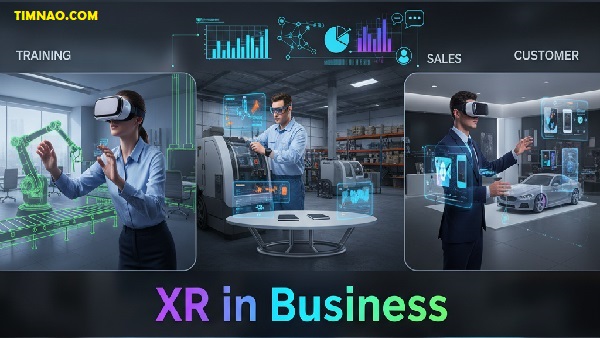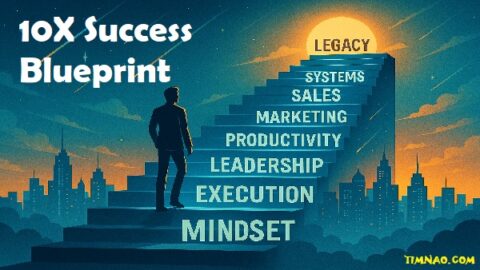XR in Business: The Surprisingly Powerful Playbook for Real‑World Wins 🚀
XR in business is no longer a futuristic buzzword—it’s a practical tool reshaping how companies train employees, streamline operations, and engage customers. Whether it’s a technician receiving step-by-step guidance through augmented reality glasses, or a team practicing complex safety procedures in a virtual environment, extended reality (XR) is driving measurable improvements in speed, accuracy, and retention.
What makes XR exciting isn’t just the technology itself, but how it transforms everyday business challenges into immersive, interactive solutions. For beginners, this might sound overwhelming—but with the right approach, you can start small, prove results, and scale confidently. This guide will break down the essentials of XR in clear, human-friendly language, packed with examples, practical tips, and a roadmap you can follow.
Let’s explore how your organization can harness XR today—not tomorrow—to save time, cut costs, and gain a competitive edge.
Table of Contents
- 🔥 Why XR in Business Matters Right Now
- 🧭 XR, AR, VR—Plain‑English Definitions for Beginners
- 💼 Where XR Delivers Value First: Training, Ops & Sales
- 🎓 VR Training for Speed, Confidence & Retention
- 🛠️ Augmented Reality on the Job: Remote Help & Workflows
- 📊 Collaboration & Data Visualization in 3D Spaces
- 🗺️ A Practical 5‑Phase XR Delivery Roadmap (Beginner‑Friendly)
- 🎥 From Idea to Content: 360° Video vs Interactive 3D
- 🧰 Hardware & Software Picks Without the Jargon
- 🤖 AI + XR: Smarter Content, Faster Builds
- 🧼 Security, Privacy & Hygiene Essentials
- 📈 Measure What Matters: KPIs & ROI in XR
- 🧱 Barriers & Pitfalls (and How to Beat Them)
- 🧠 Common Myths You Can Confidently Ignore
- 🚦 Your 90‑Day Starter Plan: From Pilot to Proof
- ✅ Key Lessons & Takeaways
🔥 Why XR in Business Matters Right Now
Extended Reality (XR in business) has moved from being a futuristic “wow factor” to a practical set of tools that solve real problems today. What once looked like something from a sci-fi movie is now being used in factories, hospitals, offices, and even retail stores. Companies across industries are already saving time, cutting costs, and improving employee skills with XR.
So why does XR matter right now? There are three main reasons: technology maturity, business needs, and workforce expectations.
1. Technology Has Finally Caught Up
A decade ago, VR headsets were clunky, expensive, and made most users dizzy within minutes. AR devices were rare and required heavy hardware. Today, standalone headsets like Meta Quest or Apple Vision Pro make high-quality XR experiences possible without wires or complex setups. Devices are lighter, cheaper, and designed for long sessions.
Cloud computing and faster internet (like 5G) also mean businesses can stream 3D content, store large XR files, and collaborate remotely in real-time. In short: the barriers that kept XR out of everyday use are quickly disappearing.
2. Businesses Need Faster Training & Better Efficiency
Companies are under pressure to train employees faster while keeping quality high. Traditional onboarding—manuals, PowerPoints, or shadowing—takes weeks or months. XR can compress that learning into days or even hours.
For example:
- Airlines use VR to train cabin crews on safety procedures in lifelike scenarios without putting anyone at risk.
- Logistics companies use AR glasses to show warehouse workers exactly which package to pick, boosting accuracy and speed.
- Retailers run VR scenarios that help staff practice customer service during peak seasons.
When businesses measure the results, they often find XR training cuts time in half and boosts retention rates dramatically.
3. Employees Expect Modern Learning Tools
Younger generations entering the workforce grew up with video games, smartphones, and TikTok. For them, XR feels natural. A flat PDF or a 40-slide PowerPoint can feel outdated, even frustrating. Offering training in VR or AR not only improves results but also helps attract and keep talent. Employees feel more engaged and confident when they can practice instead of just read.
The Competitive Edge of XR
Another reason XR matters now: competitive advantage. Early adopters in industries like manufacturing, healthcare, and retail are already reporting higher productivity and lower costs. If your competitors are using XR to train better teams or impress customers with immersive product demos, standing still means falling behind.
Takeaway for beginners: You don’t need to start big. Even one XR pilot—like a VR onboarding module or AR remote support—can prove ROI in weeks. Think of XR as a “shortcut button” for efficiency and learning.
🧭 XR, AR, VR—Plain-English Definitions for Beginners
One common barrier for beginners is the confusing alphabet soup: XR, VR, AR, MR. Let’s break it down in plain English so you can tell the difference instantly.
XR (Extended Reality) – The Umbrella Term
XR stands for “Extended Reality.” Think of it as the family name. Under it, you’ll find VR (Virtual Reality), AR (Augmented Reality), and MR (Mixed Reality). Whenever you hear XR in business, it usually means “any combination of these immersive technologies used for practical work.”
- XR = the big family
- VR & AR = the children in the family
- MR = the cousin who blends the two
VR (Virtual Reality) – A Fully Digital World
Virtual Reality is the most immersive version. When you put on a VR headset, you’re transported into a fully digital environment. You can look around, move, and sometimes interact with objects.
Practical examples in business:
- Training pilots with VR flight simulators.
- Retailers letting customers explore a virtual store before it exists.
- Healthcare using VR for surgery rehearsals or patient therapy.
Beginners tip: VR is perfect when you need employees to practice without distractions, risk, or real-world costs.
AR (Augmented Reality) – Digital Info in the Real World
Augmented Reality adds a digital layer to the real environment. Instead of replacing reality, AR enhances it. You might use AR through a smartphone, tablet, or smart glasses.
Examples in action:
- Field technicians wearing AR glasses that show instructions step by step while keeping their hands free.
- Furniture shopping apps letting customers place a digital sofa in their living room to see if it fits.
- Healthcare providers guiding patients with AR visuals during exercises.
Beginners tip: AR is best for “on the job” tasks, where you need help while staying in the real environment.
MR (Mixed Reality) – The Blend
Mixed Reality sits between VR and AR. Imagine you can see your real office but also interact with a digital 3D model of a machine sitting on your desk. The digital objects are “anchored” in the physical world, and you can walk around them naturally.
Examples:
- Design teams reviewing prototypes in real size before building.
- Architects walking clients through a future building right on the construction site.
While MR is powerful, it’s less common today because hardware is still catching up. For beginners, focus first on VR and AR—they’re more accessible and widely used.
At this point, you should have two big insights:
- XR matters now because technology is affordable, businesses need faster solutions, and employees expect modern tools.
- XR, AR, and VR are easy to tell apart once you think of them as different levels of immersion—VR for full digital worlds, AR for overlays in the real world, MR for blending the two.
As we move forward, we’ll dive deeper into where XR delivers the most value in business—from training to operations to customer engagement—and show you how to apply it step by step.
💼 Where XR Delivers Value First: Training, Ops & Sales
For beginners, XR in business can feel overwhelming. But here’s the good news: you don’t need to adopt everything at once. Most organizations find their first real wins in three key areas—training, operations, and sales/marketing. These are the “low-hanging fruit” where XR proves its value quickly and delivers ROI you can actually measure.
1. Training & Learning Development
Think about how training is done today: long manuals, endless PowerPoints, and maybe a short job shadowing session. Not only is it boring, but it’s also inefficient. People forget most of what they read within days. XR flips that script by letting employees learn by doing in safe, controlled environments.
Benefits:
- Faster onboarding—reduce weeks of training to days.
- Higher knowledge retention—interactive experiences “stick” better.
- Safer practice—rehearse high-risk scenarios without real danger.
Example: A hospital uses VR to let nurses practice handling emergencies. Instead of waiting for rare real-life events, staff gain confidence by repeating simulations.
2. Operations & Day-to-Day Work
Beyond the classroom, AR and VR make everyday work smoother and safer. Operations are where AR especially shines. By overlaying instructions or checklists in the worker’s field of view, AR reduces errors and improves efficiency.
Common uses in operations:
- AR maintenance guides: Field engineers see visual steps directly on the machine.
- Remote support: Experts provide real-time help without flying to the site.
- Process optimization: Teams run VR “dry runs” of new procedures before rolling them out.
Example: DHL tested AR smart glasses in their warehouses. Workers could see the exact location of packages on the shelf. The result? Picking speed increased by double digits, with far fewer mistakes.
3. Sales & Customer Experience
In sales, the hardest part is helping customers “see” the value of your product. XR removes imagination barriers by letting them experience it directly.
Ways XR boosts sales:
- Virtual showrooms—let customers explore products without a physical store.
- Immersive demos—allow buyers to try equipment at full scale.
- Real estate tours—buyers walk through properties remotely in VR.
Example: Furniture retailers use AR apps so customers can place digital sofas or tables in their living rooms before buying. This not only drives sales but also reduces returns, since buyers know what they’re getting.
Beginner takeaway: Don’t try to revolutionize everything at once. Start with one use case—training, ops, or sales—that clearly links to your business goals.
🎓 VR Training for Speed, Confidence & Retention
Training is where XR shines brightest, and VR training is the leading star. If you want a strong case study to pitch XR internally, this is the place to start.
Why VR Training Works Better Than Traditional Methods
When people read a manual, they only retain about 10–20% of the information. When they experience something in VR—interacting with it, repeating it, and engaging multiple senses—retention can shoot up to 75–80%. The difference is enormous.
VR training combines three things that boost learning:
- Immersion: You feel like you’re really there.
- Repetition: You can repeat scenarios until confident.
- Emotion: Realistic situations create stronger memory anchors.
Real-World Examples of VR Training
- Airlines: American Airlines trains cabin crews in VR labs where they can rehearse opening emergency exits or handling passenger scenarios. Instead of waiting for access to expensive simulators, staff can practice endlessly in VR.
- Retail: Walmart rolled out VR training to thousands of stores. Employees used headsets to prepare for Black Friday crowds, new cash register systems, and customer service challenges. The result? Faster onboarding and higher customer satisfaction.
- Energy companies: Shell built VR emergency drills where workers deal with alarms, fires, and evacuations. Mistakes cost nothing in VR, but lessons learned save lives in reality.
The Benefits for Businesses
For beginners thinking about ROI, VR training delivers measurable benefits:
- Speed: Training time is often cut in half.
- Confidence: Learners report higher confidence in applying skills.
- Safety: Staff can practice dangerous tasks without risk.
- Scalability: Once content is created, it can be rolled out to thousands of learners.
Tips for Getting Started with VR Training
If you’re considering launching VR training, here’s a simple roadmap:
- Pick a high-value scenario: Start with something that’s costly or risky to train in real life—like onboarding, safety, or customer service.
- Choose the right content format:
- 360° video if you need quick, low-cost simulations.
- Interactive 3D if employees need hands-on practice.
- Measure success: Track KPIs like time to competency, error rates, and employee feedback.
- Pilot small, then scale: Run VR training with 20–50 people first. Use feedback to refine before rolling out company-wide.
Beginner-Friendly Example
Let’s say you run a mid-sized manufacturing company. You notice new employees often take 3 months to reach full productivity, costing both time and money. With VR, you can create a simulation of the assembly process where new hires practice safely on day one. Even if you shave off just two weeks of onboarding per hire, the savings multiply quickly across your workforce.
Takeaway for beginners: If you want a quick, visible win with XR in business, VR training is your best bet. It’s engaging for employees, measurable for managers, and scalable for the organization.
We’ve seen where XR delivers the first real wins—training, operations, and sales—and why VR training is often the smartest entry point. Next, let’s zoom in further on how AR is transforming everyday work, making it easier for employees to get things right the first time.
🛠️ Augmented Reality on the Job: Remote Help & Workflows
Augmented Reality (AR) is the most “practical” side of XR in business. Instead of transporting you into a digital world like VR, AR overlays digital guidance on the real world—helping you solve problems as they happen. Think of it as Google Maps for your workday: instructions and directions, but tailored for your exact job task.
Why AR Fits Naturally Into Daily Work
In most industries, employees already use their hands and eyes to focus on tools, machines, or customers. What slows them down is flipping between manuals, calling for support, or remembering complex instructions. AR eliminates that friction by delivering step-by-step visuals directly into their field of view.
Beginners often think AR means expensive, futuristic glasses. Not true—you can start with smartphones or tablets, then scale up to headsets when workflows prove their value.
Real-World Applications of AR at Work
- Remote Expert Assistance
- A technician in the field wears AR glasses or uses a tablet.
- They share their live view with an expert in another city.
- The expert draws arrows or highlights directly onto the technician’s display.
Result: Problems are fixed faster, and companies save on travel costs.
- Workflow Guidance
- AR provides checklists and 3D arrows guiding workers step by step.
- Mistakes are reduced because every action is visually confirmed.
Example: In a factory, AR can show the correct wiring path on a machine, reducing costly rework.
- Logistics & Warehousing
- Workers wearing AR glasses see the shortest route to items on a shelf.
- They confirm items by scanning them in real time.
Example: DHL’s AR pilot boosted picking speed by around 15% and cut onboarding time for new hires by half.
- Customer Support & Field Sales
- A home appliance technician can use AR to show customers how to maintain products.
- Sales reps can demo how a product fits into the client’s real environment.
Example: A furniture company lets customers place digital couches in their living room before purchase.
Benefits for Beginners to Highlight to Leaders
- Less downtime: Fix problems on the spot with remote experts.
- Faster onboarding: Workers can follow AR guides instead of memorizing manuals.
- Standardization: Every technician follows the same visual steps, reducing variation.
- Cost savings: Fewer travel expenses and less rework.
Beginner takeaway: If you want to test AR fast, start with remote assistance. It requires little content creation and delivers quick ROI.
📊 Collaboration & Data Visualization in 3D Spaces
While AR shines in the field, VR and AR together open up new ways of working in collaborative spaces. Instead of endless video calls or flat PowerPoint slides, teams can step inside a 3D workspace where data, models, and ideas come alive.
Why 3D Collaboration Beats Flat Screens
Humans are spatial thinkers. We understand better when we see something at real scale, from multiple angles, or when we can “touch” it virtually. A 2D chart on a laptop can’t match the clarity of a 3D bar chart you can walk around in VR or AR.
For businesses, this means:
- Faster alignment on designs.
- Fewer misunderstandings in complex projects.
- Richer engagement from remote participants.
Use Cases of 3D Collaboration in Business
- Design & Prototyping
- Architects review building layouts in VR before construction.
- Engineers test product ergonomics by manipulating 3D prototypes.
- Teams can scale objects up or down, or “walk through” them at life size.
- Data Visualization
- Financial data, supply chain flows, or customer journeys are mapped into 3D spaces.
- Teams can spot patterns and bottlenecks faster.
Example: A retail team visualizes foot traffic heatmaps as 3D layers in a store mock-up, identifying where to place promotions.
- Virtual Meetings & Workshops
- Instead of flat Zoom calls, participants gather in a VR “room.”
- Whiteboards, sticky notes, and 3D models replace slide decks.
- Teams report higher focus and participation compared to video calls.
- Training Simulations with Teams
- Groups of learners can enter the same VR environment and collaborate.
- Example: fire safety drills where a whole team practices evacuation in sync.
Benefits for Beginners
- Improved understanding: Seeing data in 3D makes complex topics easier to grasp.
- Higher engagement: People stay focused when they’re active participants, not passive viewers.
- Stronger decisions: Teams agree faster when they share the same “view” of a project.
- Cost savings: Reduced travel for design reviews or workshops.
Practical Tips for Starting with 3D Collaboration
- Pick one project: Choose a design review or workshop that normally causes confusion.
- Use accessible tools: Start with platforms that run on standalone headsets or even browsers (e.g., Spatial or Glue).
- Limit sessions to 30–45 minutes: Keeps energy high and avoids fatigue.
- Combine with traditional tools: Don’t throw away Zoom or Slack—use XR workshops for specific high-impact moments.
Beginner takeaway: If you want to improve teamwork, try hosting your next design review or brainstorming session in a VR/AR space. The results will surprise you.
We’ve seen how AR boosts productivity on the job and how XR unlocks richer collaboration and visualization. Next, we’ll explore a step-by-step roadmap for delivering XR projects in your organization—so you can go from idea to impact without getting lost.
🗺️ A Practical 5-Phase XR Delivery Roadmap (Beginner-Friendly)
One of the biggest mistakes companies make with XR in business is jumping in without a roadmap. They buy headsets, hire an agency, or try a flashy demo—then lose steam because nobody knows what to measure or how to scale. The truth is, XR projects don’t have to be overwhelming if you follow a simple, repeatable process.
Here’s a 5-phase roadmap you can use as a beginner to go from idea to measurable results. Think of it as your GPS for navigating XR.
Phase 1: Discover – Define the Problem and KPIs
Before you buy hardware or brainstorm scenarios, ask: What business problem am I solving?
- Are you trying to reduce training time?
- Cut down rework in operations?
- Improve customer engagement?
Pick one KPI that matters to leadership. Examples:
- Time to competency (onboarding days).
- First-time fix rate in maintenance.
- Sales conversion rate after demos.
Beginner tip: Write your KPI as a hypothesis, e.g., “We believe VR onboarding can reduce training time by 30%.” This makes evaluation easier later.
Phase 2: Design – Map Scenarios and User Flow
Now sketch how the XR experience should look. You don’t need a 3D artist yet—use pen and paper or simple storyboards.
Questions to answer:
- Who is the learner or user?
- What is the scenario? (e.g., machine operation, customer interaction, safety drill)
- What success looks like? (e.g., completing a procedure with zero errors)
- How long should the session last? (shorter is better—10–15 minutes is ideal for beginners)
Also, think about comfort and accessibility. Will users stand or sit? Do they need subtitles? Will they use controllers or hand tracking?
Phase 3: Develop – Build a Small Pilot
Don’t aim for perfection—aim for a minimum viable product (MVP).
- Use 360° video if you need something fast.
- Use interactive 3D if the task requires hands-on practice.
- Reuse existing assets: CAD models, product photos, or training videos.
Make sure you add basic analytics hooks:
- Start and end time.
- Time spent per task.
- Errors made.
- Pass/fail outcomes.
This ensures you can measure whether XR actually makes a difference.
Phase 4: Deploy – Test With a Small Group
Run your pilot with 20–50 people. Choose a mix of beginners and experienced staff.
- Provide a 5-minute onboarding session so users feel comfortable.
- Have facilitators available for the first few sessions.
- Collect both quantitative data (time, errors) and qualitative feedback (comfort, usefulness).
Beginner tip: Don’t forget hygiene! Provide wipes, disposable face covers, and a simple “how-to” guide for using the headset.
Phase 5: Debrief – Analyze and Decide
At the end of the pilot, compare the results to your original KPI.
For example:
- If onboarding dropped from 30 days to 20 days, you’ve proven ROI.
- If rework errors decreased by 40%, you can justify scaling.
Capture feedback like quotes, screenshots, or short clips from the pilot. These make great internal marketing assets to win executive support.
Finally, decide: Do we scale or iterate? If results are strong, plan to expand. If not, tweak and try again.
Quick Recap for Beginners
- Start small: 1 KPI, 1 use case, 1 module.
- Build fast: 4–8 weeks from idea to pilot.
- Measure hard: data beats opinions.
- Scale smart: standardize hardware, software, and processes before rollout.
Takeaway: Treat XR like a business project, not a tech experiment. This 5-phase roadmap keeps you on track.
🎥 From Idea to Content: 360° Video vs Interactive 3D
Once you know your use case, the next big question is: What kind of XR content should we build? For beginners, this usually comes down to 360° video or interactive 3D. Each has strengths and trade-offs.
360° Video – The Fast Track
360° video is created by filming real environments with special cameras. Users wear a headset and “look around” as if they’re really there.
Pros:
- Quick and affordable to produce.
- Great for real-world context (factories, stores, hospitals).
- Easy for beginners to understand—just look around.
Cons:
- Mostly passive—users can’t interact with objects.
- Harder to update (you must re-film if processes change).
Best use cases:
- Safety walk-throughs.
- Customer service scenarios.
- Facility tours.
Example: A retail chain films a 360° Black Friday rush so new staff can feel the intensity before facing it live.
Interactive 3D – The Hands-On Option
Interactive 3D content is built in engines like Unity or Unreal. Users can manipulate objects, practice procedures, and explore branching scenarios.
Pros:
- Fully interactive—users can practice “doing,” not just watching.
- Easy to update by modifying 3D models.
- Allows for gamification and skill assessment.
Cons:
- More time and cost to produce.
- Requires technical expertise or external vendors.
Best use cases:
- Equipment operation.
- Emergency drills.
- Complex customer interactions.
Example: A manufacturing company creates a 3D simulation of machine assembly. Workers practice without risking damage to real equipment.
Choosing the Right Format as a Beginner
Here’s a simple decision tree:
- Do learners need awareness or context? → Choose 360° video.
- Do learners need hands-on practice? → Choose interactive 3D.
- Unsure? Start with 360° video—it’s faster and cheaper. Add interactivity later.
Hybrid Approach – The Best of Both Worlds
Many companies mix the two. For example:
- Use 360° video to set the scene (e.g., entering a worksite).
- Switch to interactive 3D when it’s time to practice a task (e.g., handling machinery).
This hybrid model balances speed and engagement while keeping costs reasonable.
Practical Tips for Beginners
- Keep it short: Aim for 5–10 minutes per module.
- Focus on one outcome: Don’t cram too much into one simulation.
- Plan for updates: Build with future changes in mind.
- Test early: Show rough drafts to real users and adjust before final production.
Takeaway: Don’t overcomplicate your first XR project. Pick the simplest content format that gets the job done and proves value fast.
Now that you know how to follow a clear roadmap and choose the right content type, the next step is figuring out hardware and software choices. In the upcoming section, we’ll break down devices and platforms without the jargon—so you can make confident beginner-friendly picks.
🧰 Hardware & Software Picks Without the Jargon
One of the most confusing parts of XR in business for beginners is choosing the right gear and tools. The market is crowded with acronyms, specs, and flashy marketing terms. Don’t worry—you don’t need to become a tech guru to make good decisions. Let’s strip away the jargon and break it down into simple categories.
Step 1: Choosing the Right Headset
Think of headsets as your “window” into XR. Different jobs require different windows.
1. Standalone VR Headsets (Beginner-Friendly)
These are wireless, all-in-one devices—no PC required. Just put it on and go.
- Examples: Meta Quest 3, Pico 4.
- Best for: Training, collaboration, retail demos.
- Why beginners love them: Affordable, portable, and easy to set up.
2. High-End VR Headsets (For Heavy Duty Use)
These connect to a powerful PC for higher graphics quality.
- Examples: Varjo XR-3, HTC Vive Pro 2.
- Best for: Complex simulations, engineering, and design reviews.
- Why they matter: Crisp visuals and precision tracking.
3. AR Glasses / Mixed Reality Headsets
These let you see the real world with digital overlays.
- Examples: Microsoft HoloLens 2, Magic Leap 2, RealWear Navigator.
- Best for: Field service, logistics, remote expert guidance.
- Why they shine: Hands-free guidance and shared “see-what-I-see” support.
Beginner takeaway: Start with standalone VR headsets. Once you’ve proven value, explore AR or high-end setups for specialized tasks.
Step 2: Don’t Forget Accessories
Small details make big differences in adoption.
- Face covers: Keep things hygienic when multiple people use the same headset.
- Carrying cases: Protect devices when moving between sites.
- Controllers vs hand tracking: For training, controllers are fine. For customer demos, hand tracking feels more natural.
Pro tip: Simplicity wins. The easier it is to use, the faster employees will embrace it.
Step 3: Software Platforms for Building XR Experiences
You’ll need tools to create and manage XR content. These fall into a few buckets:
1. Authoring Tools (No-Code/Low-Code)
Perfect for beginners who don’t want to code.
- Motive.io – Create VR training with drag-and-drop.
- Strivr – Focused on immersive learning.
- ZapWorks – Easy AR creation for marketing and training.
2. Game Engines (For Interactive 3D Content)
More flexible but require technical skills.
- Unity – Popular for VR/AR training modules.
- Unreal Engine – Stunning visuals for design and simulations.
3. Industrial AR Platforms
Tailored for enterprise workflows.
- PTC Vuforia – Widely used for AR maintenance guides.
- TeamViewer Frontline – Strong for remote expert support.
4. Device Management Systems (MDM for XR)
If you scale beyond a few headsets, you’ll need to manage updates, apps, and user access.
Step 4: Picking the Right Mix
Here’s a simple rule of thumb for beginners:
- Training pilot: Start with a Meta Quest + simple VR authoring tool (like Motive.io).
- Field service pilot: Try RealWear Navigator + TeamViewer Frontline.
- Customer demos: Use AR apps on iPads or smartphones first—then scale to headsets.
Takeaway: Don’t chase the fanciest gear. Choose the simplest setup that solves your problem.
🤖 AI + XR: Smarter Content, Faster Builds
Building XR content used to take months of 3D modeling, coding, and expensive video shoots. But now, AI is changing the game. Beginners can leverage AI to make XR development faster, cheaper, and smarter.
How AI Supercharges XR
- Content Creation
- AI can generate 3D models from photos or sketches.
- Tools like NVIDIA Omniverse and NeRF (Neural Radiance Fields) can turn 2D images into realistic 3D assets.
- Voice & Dialogue
- AI creates lifelike voice-overs for training modules.
- It can also simulate realistic conversations for soft-skills training.
- Adaptive Learning
- AI tracks learner performance in VR and adjusts difficulty in real time.
- Example: If a trainee struggles with a task, AI adds more hints.
- Faster Prototyping
- Instead of waiting weeks for a developer, you can generate rough environments with AI in hours.
- Designers can then refine what really matters.
Practical Beginner Examples
- Training simulation: AI builds a draft 3D factory floor in hours. Instructors tweak safety signs and machinery placement.
- Customer service module: AI generates natural conversations for staff to practice handling complaints.
- Marketing demo: AI creates lightweight 3D product versions for AR apps—perfect for early customer feedback.
Benefits for Businesses
- Save money: Reduce reliance on large design teams.
- Move faster: Launch pilots in weeks, not months.
- Iterate quickly: Update content as business processes change.
- Scale smarter: AI + XR means you can create many modules with fewer resources.
How to Get Started With AI + XR as a Beginner
- Pick one workflow where AI can reduce content creation time (e.g., generating 3D models from CAD files).
- Test low-risk use cases like voice narration or simple 3D props.
- Combine with human expertise—AI drafts, experts refine.
- Stay ethical: Make sure AI-generated data is accurate, safe, and doesn’t bias training outcomes.
Beginner takeaway: Think of AI as your “assistant designer.” It doesn’t replace your team—it makes them faster.
Now that we’ve tackled the tools and seen how AI accelerates content, it’s time to explore safety, privacy, and hygiene essentials. XR is exciting, but you’ll need to protect users and company data from the start.
🧼 Security, Privacy & Hygiene Essentials
When rolling out XR in business, it’s easy to get caught up in headsets, apps, and flashy demos. But the real long-term success often depends on something less glamorous: keeping devices secure, protecting data, and ensuring hygiene for users. These basics are critical, especially if you want leadership and employees to trust the system.
Why Security and Privacy Matter in XR
Unlike laptops or phones, XR devices don’t just track clicks and logins—they often capture movement, eye tracking, voice data, and even environmental scans. This makes them powerful learning tools but also sensitive devices that require extra care.
If a headset gets lost or hacked, the risks are bigger than just a stolen gadget. A competitor (or hacker) could access company training modules, designs, or sensitive procedures. That’s why security and privacy must be part of your XR playbook from day one.
Practical Steps for Device Security
- Use Mobile Device Management (MDM): Tools like ArborXR or ManageXR let IT teams control updates, apps, and access remotely—just like managing company laptops.
- Require Passcodes or Login: Even a simple PIN keeps casual misuse away.
- Encrypt Data: Make sure sensitive content is stored securely, not just sitting on the headset.
- Regular Updates: Keep firmware and apps current to patch vulnerabilities.
Beginner takeaway: Treat XR headsets like company laptops—lock, encrypt, and manage them.
Handling Privacy Concerns
Employees may worry: “Is my company tracking my eyes or recording me?” That’s why clear communication is essential.
- Be transparent: Tell users what data you collect (e.g., time spent, error rates) and what you don’t (e.g., no video recordings without consent).
- Anonymize training data: Focus on patterns and performance, not personal surveillance.
- Give opt-outs: Some users may not feel comfortable with eye-tracking features—respect that.
When people feel safe, adoption goes up.
Hygiene for Shared Devices
If multiple people use the same headset, hygiene is just as important as IT security. Nothing kills enthusiasm faster than putting on a sweaty, smudged headset.
Best practices:
- Use disposable face covers or wipeable silicone liners.
- Disinfect lenses with microfiber cloths and alcohol-free wipes.
- Provide a cleaning station with wipes, sprays, and replacement face cushions.
- Encourage breaks—shorter sessions reduce both fatigue and hygiene issues.
Pro tip: Make headset hygiene part of the training checklist. It sets the tone for professional use.
Takeaway: Security, privacy, and hygiene may not sound exciting, but they’re deal-breakers for scaling XR. By addressing them early, you’ll build trust with both leadership and employees.
📈 Measure What Matters: KPIs & ROI in XR
Once your XR project is running, the next question is: Is this working? The only way to answer is through data. Measuring XR success is about more than smiles and “cool demo” moments—you need clear Key Performance Indicators (KPIs) and a solid way to calculate Return on Investment (ROI).
Why Metrics Are Critical
- They prove value to decision-makers.
- They guide improvements for future modules.
- They prevent XR from being dismissed as a gimmick.
If you want leadership buy-in, metrics are your best friend.
Key KPIs for Training
- Time to Competency: How quickly do employees reach job-ready status?
- Error Reduction: Do trainees make fewer mistakes after XR training?
- Knowledge Retention: Test before/after to measure how much learners remember.
- Confidence Levels: Surveys show whether staff feel prepared to apply skills.
Example: A retailer reduced onboarding from 2 weeks to 5 days using VR modules—a 65% improvement they could quantify for leadership.
Key KPIs for Operations
- First-Time Fix Rate: How often do technicians resolve issues on the first try with AR guidance?
- Mean Time to Repair (MTTR): Are problems fixed faster?
- Productivity Gains: Track throughput, pick accuracy, or downtime avoided.
- Travel Reduction: Remote AR support can save thousands in travel costs.
Example: A field service team cut travel expenses by 40% after rolling out AR remote support.
Key KPIs for Sales & Marketing
- Conversion Rate: Do customers buy more after an XR demo?
- Customer Engagement: Track time spent interacting with XR content.
- Return Rates: Do AR “try-before-you-buy” features reduce refunds?
- Sales Cycle Speed: Does XR help decision-makers commit faster?
Example: An automotive company let customers customize cars in VR showrooms. The result: faster sales and fewer canceled orders.
Calculating ROI for XR
The basic ROI formula is:
ROI=Benefits−CostsCosts\text{ROI} = \frac{\text{Benefits} – \text{Costs}}{\text{Costs}}
Benefits may include:
- Labor time saved.
- Travel expenses avoided.
- Errors reduced (and costs saved from those errors).
- Sales increased.
Costs usually include:
- Headsets and accessories.
- Software licenses or subscriptions.
- Content creation (360° video or 3D modules).
- Training and support.
Practical ROI Example
Let’s say you train 200 employees per year:
- Traditional training takes 20 hours per employee.
- VR training takes 10 hours.
- That’s 2000 hours saved annually.
If your average employee costs $25/hour:
- Savings = $50,000/year.
If your XR setup (headsets + software + content) costs $30,000 in year one:
- ROI = (50,000−30,000)/30,000=66(50,000 – 30,000) / 30,000 = 66%
Beginner takeaway: Even small pilots can show ROI quickly if you measure the right metrics.
Tips for Beginners Measuring XR Success
- Start with one KPI—don’t overwhelm yourself with too many.
- Collect baseline data before launching XR (so you have something to compare against).
- Mix hard numbers and soft feedback—leaders love numbers, but employee quotes are powerful too.
- Report visually—charts, short videos, and testimonials make your case more compelling than spreadsheets alone.
Now that we’ve locked down security, privacy, hygiene, and metrics, you’re ready to move beyond pilots. Next, we’ll look at barriers and pitfalls most companies face—and how to overcome them with confidence.
🧱 Barriers & Pitfalls (and How to Beat Them)
Every new technology has hurdles, and XR in business is no exception. Beginners often run into the same set of barriers: leadership doubts, costs, employee pushback, and scaling headaches. The trick isn’t to avoid these challenges but to anticipate them and plan ahead. Let’s break down the most common pitfalls and how to beat them.
Barrier 1: Leadership Skepticism
The challenge: Many executives still think XR is a futuristic gadget or a gimmick for trade shows. They hesitate to commit budget without hard proof of business value.
How to beat it:
- Link XR to existing goals. Don’t pitch “VR for VR’s sake.” Pitch “VR that reduces training time by 40%.”
- Start small. Run a pilot with clear before-and-after metrics. Executives like numbers.
- Share stories. Collect employee testimonials and short video clips from training sessions. Real voices resonate more than slides.
When leaders see XR driving measurable impact—faster onboarding, safer operations, more confident staff—skepticism fades fast.
Barrier 2: Content Production Costs
The challenge: Building XR content can look expensive, especially when vendors push advanced 3D simulations with bells and whistles. Leaders fear cost overruns.
How to beat it:
- Choose the right format. For awareness training, start with 360° video—it’s affordable and quick.
- Repurpose assets. Use CAD files, process diagrams, and manuals you already own.
- Adopt modular design. Create small scenes (e.g., a 5-minute safety drill) instead of massive projects. These are easier to update.
- Leverage AI. AI now generates draft 3D models, dialogue, and even avatars. This slashes costs.
Think of XR like any other business investment: start lean, then scale when the ROI is proven.
Barrier 3: Employee Resistance
The challenge: Not all employees are eager to strap on a headset. Some worry about motion sickness, others fear they’ll “look silly,” and many assume it’s complicated.
How to beat it:
- Keep sessions short. 5–10 minutes works well for new users.
- Provide orientation. A two-minute walkthrough of the headset controls makes a huge difference.
- Start with volunteers. Early adopters become champions and spread positive buzz.
- Focus on value. Frame XR as a tool to help employees succeed faster, not as a “tech experiment.”
Once workers see how XR helps them reduce errors or feel confident before a risky task, resistance quickly turns into enthusiasm.
Barrier 4: Hardware Logistics
The challenge: Sharing headsets across teams creates issues: scheduling conflicts, hygiene concerns, and lost devices. Without planning, rollout becomes messy.
How to beat it:
- Device management. Use tools like ArborXR or ManageXR to track devices, push updates, and lock down apps.
- Booking systems. Treat XR headsets like meeting rooms—schedule usage to avoid chaos.
- Hygiene stations. Provide wipes, replaceable face covers, and carrying cases. Clean gear shows professionalism and care.
Smooth logistics show employees—and executives—that XR is a mature business tool, not a toy.
Barrier 5: Scaling Beyond Pilots
The challenge: Many companies run a great pilot, but then stall. Scaling requires standard processes, IT support, and ongoing budget.
How to beat it:
- Document everything. Turn your pilot process into a repeatable playbook.
- Involve IT early. They handle updates, security, and integration. Without them, scaling fails.
- Train trainers. Don’t rely on one champion; train a network of facilitators.
- Plan updates. Content ages—budget for yearly refreshes to keep modules relevant.
Scaling XR is less about technology and more about change management. With the right foundation, you can move from pilot to company-wide adoption smoothly.
Beginner takeaway: The most common barriers—leadership, cost, resistance, logistics, scaling—are predictable. Prepare for them upfront and you’ll look like a pro.
🧠 Common Myths You Can Confidently Ignore
Alongside real barriers, beginners face myths that stop them from even trying XR. These myths sound convincing at first but crumble under scrutiny. Let’s debunk the biggest ones.
Myth 1: “XR Is Only for Big Companies”
Reality: XR is already used by small and mid-sized businesses. Affordable headsets and no-code platforms make it accessible. A local auto shop can use AR glasses for remote diagnostics just as easily as a global car manufacturer.
Myth 2: “It’s Too Expensive”
Reality: A Meta Quest headset costs less than a mid-range office laptop. Creating a simple 360° video module is comparable to producing a short training video. ROI often shows within months by cutting training time or reducing travel.
Myth 3: “Our Employees Aren’t Tech-Savvy Enough”
Reality: If employees can use a smartphone, they can use XR. Interfaces are intuitive, with hand tracking and simple menus. In fact, XR often feels more natural than reading a manual because it’s visual and hands-on.
Myth 4: “XR Will Replace Human Trainers”
Reality: XR enhances trainers, it doesn’t replace them. Trainers set context, lead discussions, and provide feedback. XR provides the practice ground. Together, they create better outcomes.
Myth 5: “You Need Fancy Glasses for AR”
Reality: AR works fine on devices you already own—smartphones and tablets. You don’t need to buy HoloLens or Magic Leap until you’re ready to scale advanced workflows.
Myth 6: “XR Is Just a Gimmick”
Reality: Walmart trains employees for Black Friday with VR. UPS trains drivers in VR. Boeing uses AR for wiring assembly. These are not gimmicks—they’re cost-saving, life-saving, efficiency-boosting use cases.
Beginner takeaway: Don’t let myths stop you. XR is no longer futuristic or niche—it’s practical, affordable, and already making companies of all sizes more competitive.
You now understand the real barriers that can trip up XR projects—and how to overcome them—as well as the myths that don’t deserve your attention. In the final section, we’ll distill all the lessons into key takeaways you can act on immediately, whether you’re starting your first pilot or planning to scale across the enterprise.
🚦 Your 90-Day Starter Plan: From Pilot to Proof
Starting with XR in business can feel overwhelming, but you don’t need a 12-month master plan. What you need is a 90-day starter roadmap to get from idea to proof of value. Three months is enough time to test, measure, and decide whether XR deserves more investment.
Days 1–30: Discovery & Setup
- Pick one problem. Don’t overcomplicate—choose training, ops, or sales where XR could help.
- Define one KPI. For example: “Reduce onboarding time by 25%” or “Increase first-time fix rate by 15%.”
- Select your tools. Start with standalone VR headsets (like Meta Quest 3) and a no-code platform to build quickly.
- Assemble a small team. Include one sponsor (manager/executive), one trainer, one IT contact, and 5–10 pilot users.
Beginner tip: Don’t try to solve everything. One KPI, one use case, one module.
Days 31–60: Build & Pilot
- Create the pilot module. Choose 360° video if you want speed, interactive 3D if you need hands-on practice.
- Run the first sessions. Keep modules short (5–10 minutes). Provide wipes, covers, and quick onboarding.
- Collect data. Track usage time, completion rates, and errors. Gather quotes from participants about how they feel.
- Fix early issues. Tweak the content or hardware setup based on feedback.
Beginner tip: Record a short demo video of employees using XR—this helps when presenting results.
Days 61–90: Measure & Share Proof
- Compare before vs. after. Did training time drop? Did error rates fall? Did employees report higher confidence?
- Calculate ROI. Use saved labor hours, avoided travel, or increased sales to put numbers on benefits.
- Package results. Create a short deck or video with data + testimonials.
- Pitch scale-up. Present the proof to leadership and propose expanding to the next team or use case.
Beginner tip: Don’t aim for perfection. Aim for proof. A successful pilot is a stepping stone, not the final destination.
Takeaway: In 90 days, you can go from “we should try XR” to “XR reduces training time by 40%—here’s the proof.” That’s how you win support and budget.
🙋 FAQs: Beginner Questions About XR in Business Answered
1. Do I need expensive headsets to start?
No. You can start with standalone VR devices like Meta Quest, or even run AR pilots on iPads and smartphones. Advanced headsets are great later, but not essential at the beginning.
2. What if employees get motion sickness?
Most modern devices have improved significantly. Keep sessions short (under 10 minutes at first), use seated experiences, and avoid unnecessary movement. Most users adapt quickly.
3. How long does it take to create XR content?
It depends. A 360° video module can be built in 2–4 weeks. Interactive 3D modules may take 6–12 weeks. AI tools can speed up asset creation. Start small and build iteratively.
4. Can XR really work for non-tech industries?
Yes. XR is already used in healthcare (nurse training), construction (safety drills), retail (customer service), logistics (warehouse operations), and more. If your employees need to learn, practice, or explain something, XR can help.
5. How do I convince leadership to invest?
Show them proof, not promises. Run a small pilot, measure one KPI, and present results with both numbers and employee feedback. Executives respond to evidence.
6. What if IT pushes back?
Involve IT from day one. They’ll care about device management, security, and integration. Frame XR as a standard business tool, just like laptops and phones, and show them how MDM tools simplify control.
7. How do I scale beyond pilots?
- Document processes.
- Train multiple facilitators.
- Budget for updates.
- Standardize hardware/software choices.
Scaling is less about tech and more about process and change management.
✅ Key Lessons & Takeaways
To wrap up, here are the most important lessons from this guide:
- Start small, prove fast. One KPI, one module, one pilot can show value in under 90 days.
- Training is the easiest entry point. VR onboarding and safety modules deliver quick ROI and high employee engagement.
- AR fits perfectly on the job. Use AR for remote support, maintenance workflows, and real-time guidance.
- Hardware and software don’t have to be complicated. Begin with standalone VR headsets and no-code platforms.
- AI accelerates XR. Use AI to generate 3D models, voices, and adaptive learning flows.
- Security and hygiene matter. Treat headsets like laptops: secure, managed, and clean.
- Measure what matters. KPIs like time to competency, error reduction, and sales conversion prove business value.
- Anticipate barriers. Leadership doubts, costs, resistance, and scaling can all be overcome with planning.
- Ignore myths. XR is not too expensive, not just for big companies, and not a gimmick. It’s already delivering results worldwide.
Final encouragement: XR in business isn’t about chasing shiny gadgets—it’s about solving real problems faster, safer, and smarter. Start with a simple pilot, measure results, and let the proof speak for itself. The sooner you begin, the sooner you’ll see the competitive edge XR can give your organization.










Your blog is a breath of fresh air in the crowded online space. I appreciate the unique perspective you bring to every topic you cover. Keep up the fantastic work!
Thanks
Rattling superb information can be found on web site.